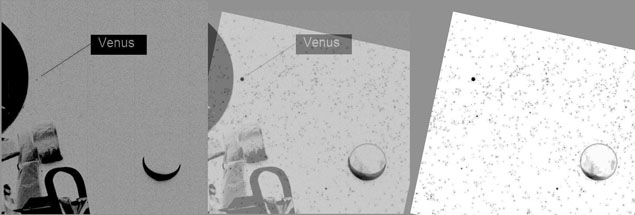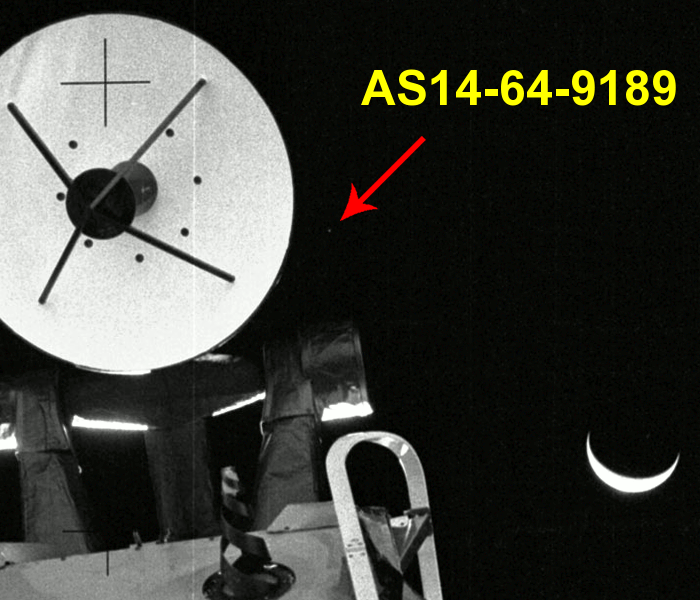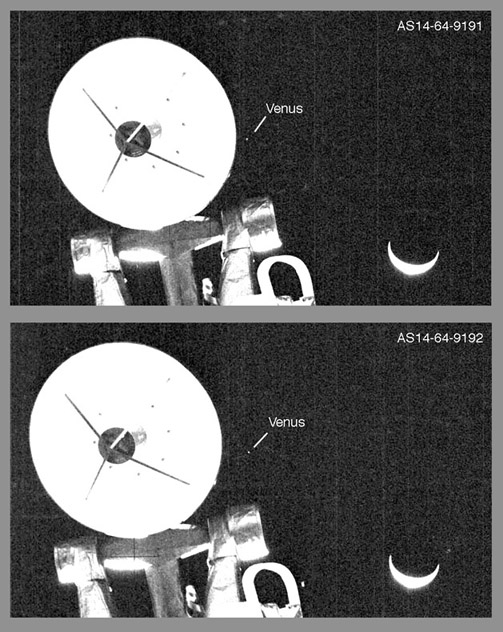
This comparison has a negative (reverse) detail from AS14-64-9191
on the right and a negative detail of Venus and the Earth from Starry
Night. The latter has been rotated and scaled to match the
mission photo. An overlay of the two images is shown at the
center. Note that we are able to match both the separation
between Venus and the Earth and the Earth's size, which further
confirms that the star-like object is Venus.
Even though Venus's angular diameter as
seen from the Moon was only 21 arc seconds - about 1/325th of Earth's
- it has the same surface brightness it would have if we were
right on top of it, because of the inverse square law of light
propagation. Because Venus is covered with clouds, and closer to the
Sun, its surface brightness is roughly twice that of Earth.
Consequently, an exposure that gets the Earth right, will also
necessarily show Venus. This is why you can see Venus in broad daylight
if you know exactly where to look - and can manage the trick of
focusing at infinity when confronted with an otherwise featureless
scene.
As mentioned above, Venus is
present in all nine of the images in Al Shepard's sequence of Earth
photos. In many of the images, we can also see bright spots
which, because they don't repeat from frame to frame, are undoubtedly
due to dust on the film or on the scanner, or some other cause
unrelated to what was actually in the sky over Fra Mauro. In the
following film strip, the details from the mission photos are presented
at the same scale and with the same brightness enhancement (255 levels
reduced to 50). For ease of comparison, an L-shaped figure was
drawn from the detail of AS14-64-9192 with the longer line connecting
the horns of the crescent Earth and the shorter line pointing at
Venus. The L-shaped figure was then superimposed on each of the
other frame details after a rotation needed to put the figure into same
orientation relative to the crescent and to Venus. No scaling was
done. Rotation of the L-shaped figure is necessary because
Shepard took the photos while holding onto the LM ladder, leaning back,
and holding the camera in his hand. As can be seen in the film
strip, he was in much the same position while taking each of the first
five photos but then leaned to his right - moving Venus away from the
rendezvous radar antenna - for the last four photos. Possibly he
saw Venus and shifted to his right to ensure that he captured it in at
least the last four images. We don't
know if he changed f-stops, but all the frames were undoubtedly taken
at 1/250th of a second.

Animated gif by Yuri Krasilnikov,
after a similar animation posted
at ApolloHoax.net
by 'Data Cable'.

Details from the nine frames taken by Al Shepard at about 1207
GMT/UT on 6 February 1971. The L-shaped figure was constructed as
an overlay to 9192 with the long line connecting the horns of the
crescent Earth and the short line pointing at Venus. The L-shaped
figure was then superimposed on the details from the other frames after
a rotation to reproduce the positon of the figure relative to the
crescent Earth and Venus. No scaling was done. Note the
various star-like spots, particularly in the later frames.




